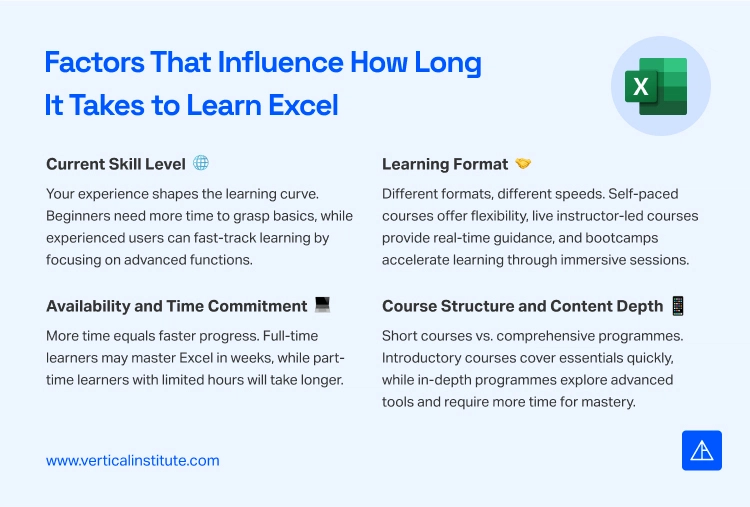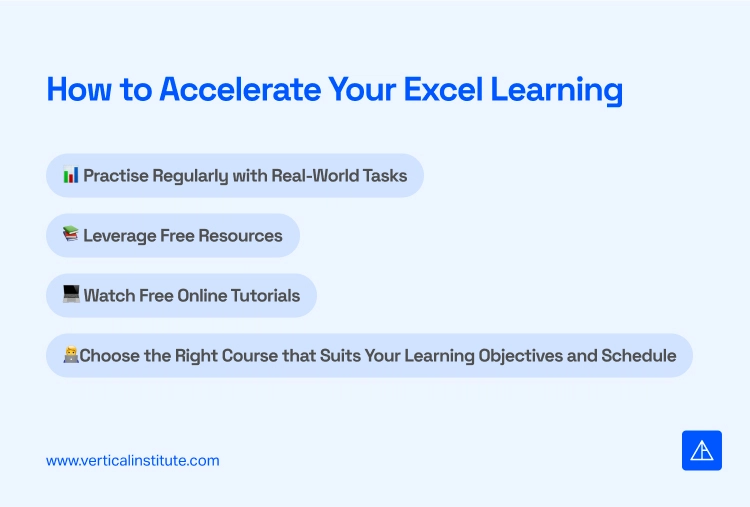Excel Course Duration: How Long It Takes to Learn Excel
In this article, you’ll learn how to fast-track your Excel skills with practical tips and resources designed to make learning more efficient. Whether you’re a beginner or looking to refine advanced techniques, this guide will show you how to enhance your Excel proficiency while finding the right course that fits your schedule and career objectives.
by Vertical Institute • 3 October 2024 • minutes read
Microsoft Excel is an essential tool in industries such as finance, data analysis, and project management. Its wide application in fields such as marketing, human resources, and operations makes Excel a crucial skill for professionals aiming to improve efficiency and career prospects. Excel’s ability to streamline workflows and support data-driven decisions has made it indispensable in today’s workplace.
According to Microsoft, Excel’s Analyze Data feature helps users quickly identify trends, generate summaries, and uncover patterns in large datasets, enabling faster, more informed decisions and boosting productivity.
But how long does it take to master Excel? The answer varies depending on your current skill level, the complexity of the course, and the time you can commit to practise.
In this article, we’ll break down the timeframes for learning Excel at different levels, including Excel course duration when attending a bootcamp. By the end, you’ll know what to expect and how to tailor your learning path effectively.
Related: How To Get Started in Excel?
Factors That Influence How Long It Takes to Learn Excel
Several factors can impact the time it takes to master Excel, from your current experience with the software to the format and depth of the course you choose.
According to ITPro, using Excel for data analysis requires a deeper understanding of the platform’s advanced tools than simply using it for data management. Analysing data with Excel involves learning more sophisticated features like Power Query, Power Pivot, and Excel’s built-in analytics tools, all of which take time to master. By contrast, data management, such as organising and storing data, is generally quicker to learn and requires fewer advanced skills.
Similarly, as highlighted by CIO.com, professionals in leadership roles benefit from learning advanced Excel tools for better data-driven decision-making. These more advanced tools take longer to master but are invaluable in efficiently managing and interpreting complex datasets.
Here’s a breakdown of the key elements that determine how quickly you can become proficient in Excel:

1. Current Skill Level
Your existing proficiency with Excel heavily influences the time required to learn it. Beginners with little to no experience with spreadsheets will need more time to grasp essential functions like navigation, basic formulas, and formatting. Intermediate or advanced users, especially those familiar with other data tools, may learn faster as they already have a software or data management foundation. This allows them to skip the basics and focus on more complex features such as data visualisation, PivotTables, and VLOOKUP.
2. Learning Format
The method you choose for learning Excel can greatly impact how quickly you progress:
- Self-paced online courses
These are flexible and convenient but depend on the learner’s motivation and discipline. Completing a course can take longer without the structure of set deadlines or live guidance.
- Live instructor-led courses:
Whether online or in-person, this format provides direct feedback and structured guidance, often speeding up learning by offering real-time solutions to problems.
- In-person workshops or bootcamps
These immersive, hands-on experiences condense learning into a shorter timeframe, allowing participants to build skills rapidly. However, the intensity of these sessions may require learners to dedicate significant time upfront.
3. Availability and Time Commitment
How much time you can dedicate to learning Excel each week is a critical factor in determining the duration of your learning journey. Full-time learners who can focus several hours a day on Excel may complete even advanced courses in days or weeks. Part-time learners, who only have a few hours each week, will take longer to achieve the same proficiency, stretching their learning period over months.
4. Course Structure and Content Depth
- Short, focused courses
These usually cover the basics quickly, such as simple formulas, data entry, and formatting. They are ideal for those needing a fast introduction to Excel but won’t cover advanced features.
- In-depth programmes
These courses are more comprehensive, covering everything from data visualisation to automation with macros and advanced formulas. Such courses will naturally take longer but offer a broader and more robust skill set.
How to Accelerate Your Excel Learning

With the right approach, you can significantly speed up your learning. Here are some practical tips and strategies to help you quickly build your Excel skills.
Practise Regularly with Real-World Tasks
Incorporate Excel into daily tasks like budgeting, data analysis, or project management. For example, manage a budget using formulas like SUMIF to track expenses, automate totals, and create charts to visualise trends. This not only sharpens your skills but also serves a practical purpose.
Leverage Free Resources
Use free Excel templates like budget planners or project trackers to explore practical examples. For instance, a project tracker template can help you understand how to manage timelines, use conditional formatting, and track progress with built-in functions, giving you hands-on experience with key Excel features.
Watch Free Online Tutorials
Explore platforms like YouTube for step-by-step guidance on Excel features. For example, tutorials on advanced functions like PivotTables or VLOOKUP can walk you through real-time data analysis, helping you grasp basic and advanced Excel techniques efficiently.
Choose the Right Course that Suits Your Learning Objectives and Schedule
Select an Excel course that fits both your time availability and learning goals. Self-paced online courses offer flexibility, allowing you to progress at your own speed. If you prefer a more structured and fast-tracked approach, instructor-led or bootcamp-style courses are ideal. Vertical Institute’s featured course for learning Excel is through the Data Analytics programme. This course focuses on essential Excel skills such as Data Referencing, Aggregation, and Analysis, VLOOKUP for efficient data searches, Pivot Tables for summarising large datasets, and Pivot Charts for visualising trends. It equips learners with practical, in-demand Excel skills essential for data-driven roles.
Conclusion
The time it takes to learn Excel depends on your prior experience, the course structure, and how much time you can commit. Whether you are a beginner or looking to master advanced features, the right course can accelerate your learning journey. Excel’s versatility across industries and its ability to streamline workflows make it an invaluable tool for professionals.
Investing time to learn Excel improves productivity, decision-making, and career opportunities. If you’re ready to build your Excel skills, explore Vertical Institute’s Data Analytics course, designed to cater to different skill levels and schedules. Check out our free workshops and events to learn more about other in-demand courses offered at Vertical Institute and see which ones align with your career goals!
About Vertical Institute
Vertical Institute is shaping the future of work by preparing individuals for tomorrow’s job market. Our courses and certification focus on teaching essential skills and nurturing the next generation of innovators and leaders.
As an Approved Training provider (ATO) accredited by SkillsFuture Singapore (SSG) and the Institute of Banking & Finance Singapore (IBF), our courses adhere to the highest standards. They are government-subsidised and eligible for SkillsFuture Credits or NTUC UTAP Funding.